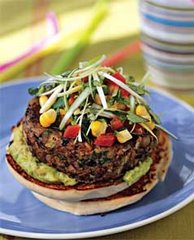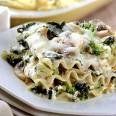My seven year old is a vegetarian. When she started her quest of avoiding meat we thought just cutting out meat itself would be enough, but it has become a journey of shocking, jaw-dropping discovery at just what contains ground-up animal parts. As a result, I am now a veggie. So I have gone from researching good recipes and nutritional information, which is essential for such a young vegetarian, to the family taking on a healthier, more compassionate outlook on life.
Thursday, 5 April 2007
One stem-cell or two?
I came across this article on the New Scientist website. At first I thought, ‘no, never,’ but then you read that NASA are involved and, lets face it, if it wasn’t for NASA we wouldn’t have microwaves and Velcro, amongst thousands of other things, then you start to worry that this could actually happen.
This would be the one time you couldn’t say ‘stranger things have happened,’ because nothing could be stranger than this! The article reads......
Lab-grown steaks nearing the menu
Fancy a beefburger, but want to spare the cow? Tissue engineers experimenting with ways of growing meat in a lab dish could soon provide a solution.
The aim of the work is to develop food for astronauts on long space journeys, such as a mission to Mars. But like much other space research, what happens up there could one day become commonplace down here too - just look what happened to Velcro.
A NASA-funded team led by Morris Benjaminson, at Touro College in New York City, has already taken the first steps. The team removed chunks of live muscle tissue from freshly killed goldfish and raised them in a standard cell-culture fluid for a week. The tissue grew by as much as 14 per cent, thanks to partially differentiated "myoblast" cells in the adult muscle dividing to make more muscle cells, he says.
But growing larger pieces of muscle tissue in the lab will be tricky. The main problem is ensuring a constant supply of nutrients for the growing cell mass. In a tissue fed by a blood supply, the capillaries must be no more than 200 microns apart or else the cells in between become necrotic and the tissue dies.
Although the Touro team developed techniques for growing white and dark chicken muscle in the lab, without a blood supply the chicken meat grew for just two months before it was dead in the dish. Benjaminson is now submitting another NASA proposal to investigate mechanical or electrical methods of stimulating blood vessel growth.
However, in a cruel setback for astronaut omnivores, NASA has rejected Mironov's proposal, apparently preferring astronauts to be vegetarians for the meantime. "People are vegetarians and vegans on Earth and they do quite well," comments Thomas Dreschel, director of NASA's Fundamental Biology Outreach Programme. "It is more efficient to grow plants and feed on them. If astronauts really need essential amino acids, they can eat a pill."
Select cut
But Douglas McFarland, at South Dakota State University in Brookings, disagrees: "Animal protein is a more balanced and complex protein than a plant protein," he argues. "The body would absorb and metabolise protein from a pill too rapidly. If you eat protein, then it takes more time to digest."
Gaining general consumer acceptance of such meat might be possible if it tasted good. But the reaction of vegetarians and animal rights campaigners is another matter. If no animal is farmed or slaughtered, and if culturing cells were more energy efficient than growing meat on the hoof, would that make it ethically acceptable?
If not, there might still be another way. One researcher recalls a student, a vegan, who asked if she could just biopsy herself, grow up a steak and eat it. If you want to eat truly victimless meat, perhaps it is time to put yourself on the menu.
To see the full article visit www.newscientist.com/article.ns?id=dn3208
My vegetarian friend said she still wouldn’t eat it and I would have to agree.
This would be the one time you couldn’t say ‘stranger things have happened,’ because nothing could be stranger than this! The article reads......
Lab-grown steaks nearing the menu
Fancy a beefburger, but want to spare the cow? Tissue engineers experimenting with ways of growing meat in a lab dish could soon provide a solution.
The aim of the work is to develop food for astronauts on long space journeys, such as a mission to Mars. But like much other space research, what happens up there could one day become commonplace down here too - just look what happened to Velcro.
A NASA-funded team led by Morris Benjaminson, at Touro College in New York City, has already taken the first steps. The team removed chunks of live muscle tissue from freshly killed goldfish and raised them in a standard cell-culture fluid for a week. The tissue grew by as much as 14 per cent, thanks to partially differentiated "myoblast" cells in the adult muscle dividing to make more muscle cells, he says.
But growing larger pieces of muscle tissue in the lab will be tricky. The main problem is ensuring a constant supply of nutrients for the growing cell mass. In a tissue fed by a blood supply, the capillaries must be no more than 200 microns apart or else the cells in between become necrotic and the tissue dies.
Although the Touro team developed techniques for growing white and dark chicken muscle in the lab, without a blood supply the chicken meat grew for just two months before it was dead in the dish. Benjaminson is now submitting another NASA proposal to investigate mechanical or electrical methods of stimulating blood vessel growth.
However, in a cruel setback for astronaut omnivores, NASA has rejected Mironov's proposal, apparently preferring astronauts to be vegetarians for the meantime. "People are vegetarians and vegans on Earth and they do quite well," comments Thomas Dreschel, director of NASA's Fundamental Biology Outreach Programme. "It is more efficient to grow plants and feed on them. If astronauts really need essential amino acids, they can eat a pill."
Select cut
But Douglas McFarland, at South Dakota State University in Brookings, disagrees: "Animal protein is a more balanced and complex protein than a plant protein," he argues. "The body would absorb and metabolise protein from a pill too rapidly. If you eat protein, then it takes more time to digest."
Gaining general consumer acceptance of such meat might be possible if it tasted good. But the reaction of vegetarians and animal rights campaigners is another matter. If no animal is farmed or slaughtered, and if culturing cells were more energy efficient than growing meat on the hoof, would that make it ethically acceptable?
If not, there might still be another way. One researcher recalls a student, a vegan, who asked if she could just biopsy herself, grow up a steak and eat it. If you want to eat truly victimless meat, perhaps it is time to put yourself on the menu.
To see the full article visit www.newscientist.com/article.ns?id=dn3208
My vegetarian friend said she still wouldn’t eat it and I would have to agree.
Subscribe to:
Post Comments (Atom)
































No comments:
Post a Comment